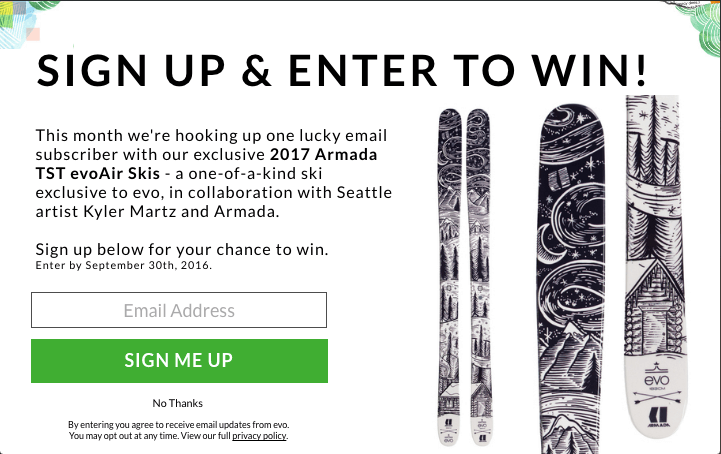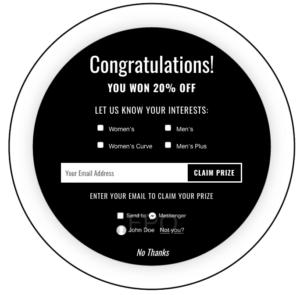Advanced Tactics For Building Your Email List (and Segmenting Your Customers for Higher Conversions)
OK, so you’ve implemented some best-practice pop-ups on your site. Your email list has grown. Now comes the question: “How do you optimize to build your list FASTER?”
By now, you know that the size and quality of your list equals revenue for ecommerce email marketing. To optimize, we’re going to show you how to build your list even faster with qualified customers that are ready to buy.
1. Segment & optimize for individual channels
You cannot simply “set and forget” when it comes to lead capture. A generalized lead capture campaign is a great starting point, but as you continue to drive more traffic to your site through various channels, one of the easiest ways to level-up your conversions is to start treating these visitors differently as they arrive on-site.
Let’s take a look at a few of the best ways to optimize your email capture strategy for each of your specific marketing channels.
Optimizing conversions from paid traffic
Out of all the traffic you’re generating to your website, if there’s one channel to focus on first, it’s those segments you pay so handsomely for.
How? Consider the qualities of each paid channel and learn what those segments respond well to.
A tried and true example would be creating a contest for capturing social media visitors. When these visitors land on your page after clicking on your ad, you can mirror the messaging from your advertising to immediately prompt their entry into the contest.
One of our customers, Calm blanket, shows an email opt-in in exchange for a chance to win free blanket (with a $119 value).

Another longtime Justuno customer, evo, runs contests for their paid traffic and grew their email list by promoting a prize directly relevant to the target audience.
With this targeted offer, they captured over 14,000 emails in just one month! Have you ever considered how many emails you could begin marketing to for only the cost of one of your products?

Now here’s the rub: after observing hundreds of stores, we note Facebook traffic in particular is more difficult to convert than organic search traffic.
Because of this, it is VITAL that you segment the list you build from paid traffic.
More often than not, purchase intent is higher in organic search traffic than it is in social traffic like that from Facebook (or elsewhere for that matter). For this reason, we suggest learning as much as possible about this social traffic without completely ruining their site experience, so that you can segment these customers and offer them more targeted content and promotions.
To do so, you’ll need to add more fields to your pop-up. In the event this visitor opts-in to your offer, but leaves your site without purchasing, you can now follow up with more tailored marketing (yay, segmentation!) via email, Messenger or SMS. Some starter fields you can add could be:
- First name (if you’re only displaying the “email address” field on your current offer)
- Allow yourself to personalize email subject line and text with their first name
- Gender (if applicable)
- Know what type of marketing emails they would like to receive/would be effective based on their gender
- Clothing style/shoe size/other product preferences
- Send targeted emails with the “top sellers” or “on-sale” items of a specific size or type. Letting visitors tailor their own marketing to match their preferences can increase opt-in rates despite these extra pieces of info.

Here’s an example of collecting more information (bonus: note the Facebook Messenger integration. This offer will automatically opt-in a visitor if they check that box and submit).
If you’re scared the addition of extra fields may decrease your opt-in rate (we suggest A/B testing), then you can always leverage Justuno’s hidden fields to gather more information without interrupting the user experience. Examples of these hidden fields might be:
- IP address (where is this person located?)
- Unique coupon codes (what code did this person use?)
- Referring URL (where did this person come from?)
This “hidden” information can push into your user profiles which helps you continuously create more personalized segments.
Optimizing conversions from organic traffic
Outside of paid ads, the traffic your site is receiving organically needs a different strategy than the one you’re using for paid ads. One of the biggest differences is organic traffic may not need a discount to capture their email address. Why? On average, conversion rates are 10 times higher from organic search than from social on desktops.
These people are already interested in your company, and they are further down your funnel, so why reduce your AOV with an unnecessary special offer? Save your discount spends for those expensive paid channels rather than waste it on visitors already inclined to complete a purchase.
For this type of traffic, instead you can set up a basic New Visitor lead capture. This may sound quite obvious, but you would be surprised at how many e-commerce websites show an email capture offer intended for hard-to-convert traffic to new organic visitors. Making this small targeting distinction in your welcome offers will help you hone-in on traffic coming from organic search and you will notice higher submission rates (and probably higher quality leads, too).
Of course, everyone’s audience is different, so we always recommend A/B testing these strategies to make continuous improvements. Based on our observations, many e-commerce sites simply do not need to discount for their new visitors in order to capture leads. Just make sure you’re segmenting by channel with these best practices in mind.
2. Increase your engagement rate
Are website visitors engaging with your offers? If not, you can increase those metrics by doing one simple thing: identify your highest-trafficked landing page and start there with on-site promotion strategy. Here are some ideas:
Seasonality
What marketing holidays or special events can you piggy-back? No matter the vertical your business is in, you can always find an excuse to create an on-site marketing offer for your highest-trafficked pages. Some examples could be:
- Back to School: create a “threshold” offer which changes depending on the amount in the visitor’s shopping cart. “Buy $X, get X free”
- Early access to Black Friday and Cyber Monday deals: create an opt-in with the incentive to gain early access to your BFCM sales before they go live to the public.
- Company/Customer Anniversary: deploy a special offer celebrating a unique milestone or thanking loyal customers with a small free gift or add on.
- Marketing Holidays: From Valentines Day to National Just Because Day, there’s no shortage of real and ‘less-than-real’ holidays to take advantage of in your messaging.
Here’s an example of Ella + Mila taking advantage of a marketing holiday, “National Nail Polish Day” by showing a bottom website banner with a unique coupon code for 20% off.
Check out our full marketing calendar here to get even more holiday inspiration.

Delay times
Another easy way to increase your on-site offer engagement rate is to consider your delay times until a promotion ‘fires’ for a visitor. Experimenting with these times can completely change engagement rates, and there are certain strategies you can keep in mind to optimize this.
Paid traffic delay times
This traffic tends to have a higher bounce rate, and more importantly, less time spent on site before bouncing. Paid traffic wants to be quickly presented with the promotion they were promised in the ad. We suggest a delay time of 5-10 seconds or less for paid traffic.
Organic traffic
User experience is crucial for all segments, but organic traffic has more intent to be on your site than paid traffic. It makes sense to let organic traffic explore some before making an ask. With organic traffic, longer delays in showing a promotion will result in higher submission rates and lower bounce. We suggest a delay time of 10-20 seconds for organic traffic to your site, or even waiting for the visitor session’s second or third page.
What you can do today
Any of the above suggestions are ready-to-go strategies that you and your team can implement today. Pick a section and decide how you want to change your existing pop-up strategy, give your changes time to settle in, evaluate, and then move on to the next optimization tip listed above. If you need more help or step-by-step guidance, keep your eyes on the Justuno Academy, which we’re regularly updating with in-depth procedure guides.






